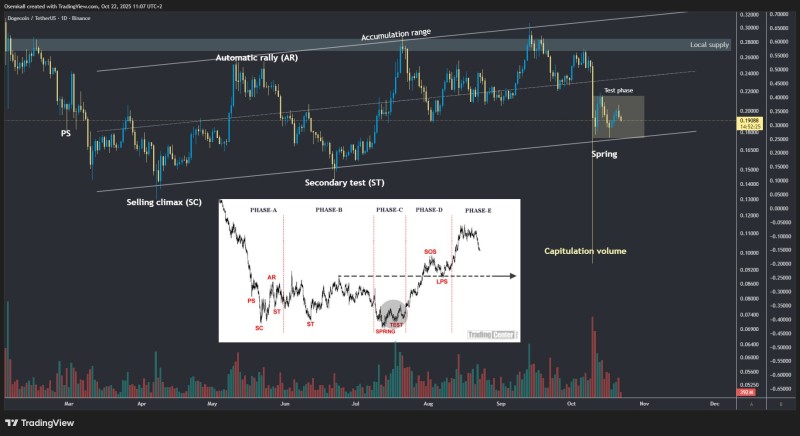Dogecoin (DOGE) recent price action is closely following a textbook Wyckoff accumulation model, a pattern typically seen at the end of extended downtrends. The structure displays all the classic phases from selling climax through to the current test phase, suggesting that large players may be quietly absorbing supply while retail sentiment remains cautious.
Dogecoin Builds a Classic Wyckoff Structure
In a recent tweet, trader Osemka highlighted that DOGE "follows the OTHERS index almost 1:1", describing the ongoing setup as a "perfect Wyckoff accumulation range."

The chart clearly outlines this structure, from the Selling Climax and Automatic Rally through the Secondary Test and Spring phases. This step-by-step sequence, combined with rising volume during the capitulation period, indicates smart money may be positioning for a reversal while broader market sentiment remains bearish.
Chart Analysis: Phases, Volume, and Accumulation
Key Technical Levels:
- Accumulation range: $0.18 to $0.32
- Support zone (Spring): ~$0.18
- Resistance targets: $0.28–$0.30
- Invalidation level: Below $0.18
Dogecoin's daily chart displays a broad consolidation base within the range mentioned above. The Selling Climax marks the initial sharp drop, followed by the Automatic Rally as selling pressure eases. The Secondary Tests confirm the lower boundary, while the Spring phase triggers capitulation volume before demand steps in. The current Test Phase represents the market's attempt to confirm stability and readiness for an upward move. Volume analysis supports this view, with the capitulation spike aligning with Wyckoff's "Phase C," where institutional players typically accumulate positions.
Market Sentiment and Broader Context
DOGE's correlation with the OTHERS index suggests its pattern reflects broader altcoin market behavior. As capital rotation from Bitcoin into major altcoins accelerates, Dogecoin's technical setup strengthens the case for a cyclical reversal. The current sideways trading and fading volatility indicate a maturing accumulation structure. This calm period often serves as the "cause" phase before the "effect" manifests as a markup rally that can push prices toward upper-range resistance near $0.28–$0.30.
 Eseandre Mordi
Eseandre Mordi

 Eseandre Mordi
Eseandre Mordi


